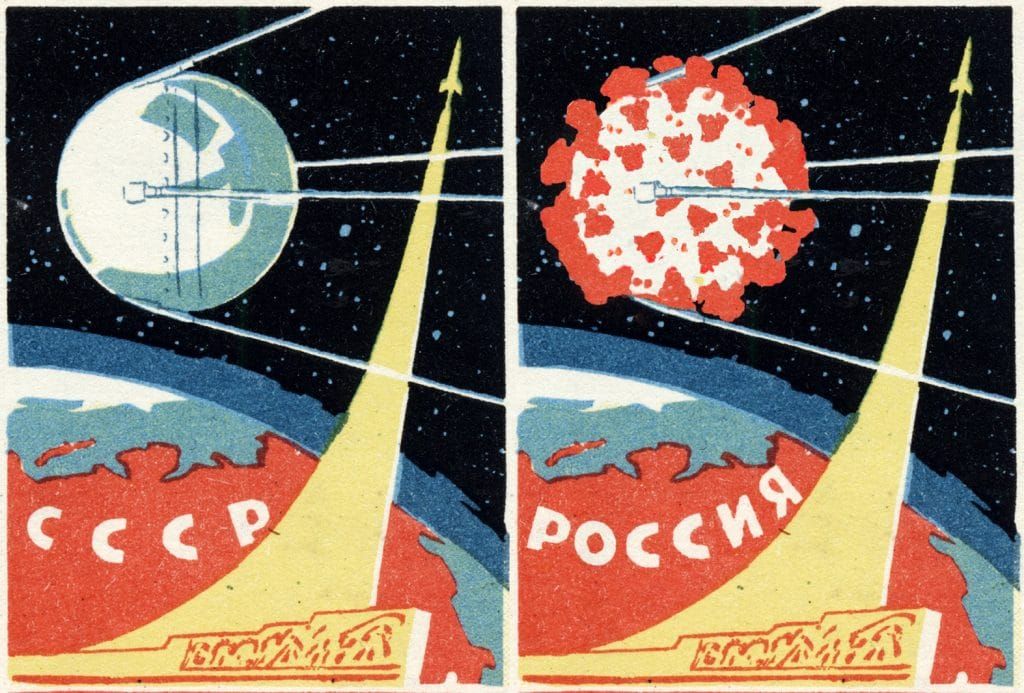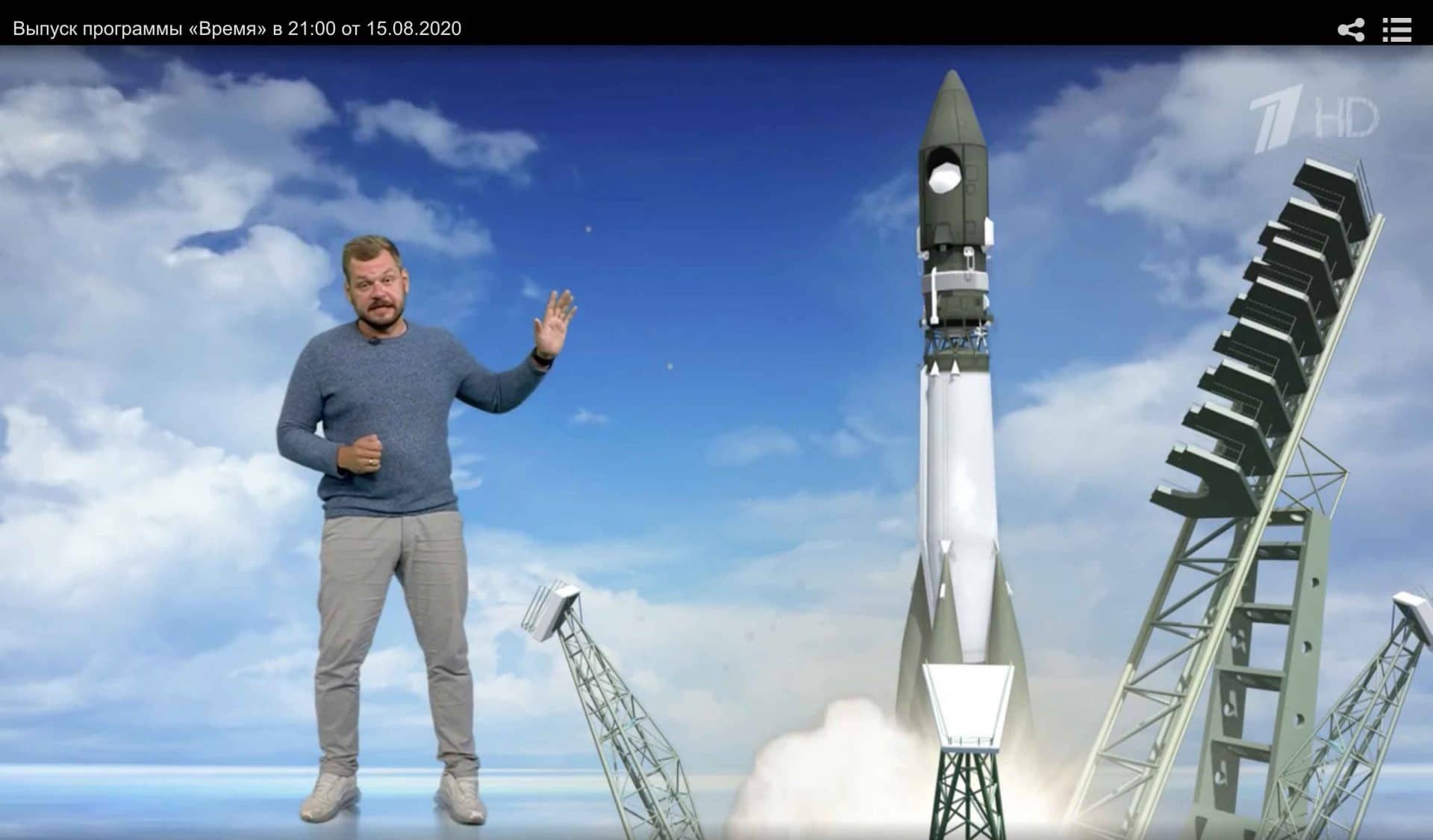The vaccine and the satellite: A tale of two Sputniks
By Matt Field | August 24, 2020
 Illustration by Thomas Gaulkin.
Illustration by Thomas Gaulkin.
On October 4, 1957, Soviet scientists shocked the world and launched a “new moon” into Earth’s orbit, a metal beach ball-sized sphere with radio transmitters and batteries. Amateur radio enthusiasts and the news media listened for Sputnik, the first manufactured satellite, as it circled 500 miles overhead beeping–a simple sound that conveyed a powerful message: The Soviet Union had beaten the United States into space and had the technology to launch a missile-bound nuclear weapon at cities around the world.
Fast forward nearly 63 years, and the Russian government is again touting a transformative scientific achievement, what it is calling the first “registered” vaccine against COVID-19. In a zero-nuance PR campaign, a government investment fund and the vaccine developer are figuratively tying the inoculation directly to the glory days of the space race. They’re calling the vaccine Sputnik V and have even released an animation showing a satellite shaped vaccine destroying a planet-sized SARS-CoV-2 virus.
After the Soviets launched the first Sputnik, the physicist William C. Davidon wrote in the Bulletin, the “myth of inherent US supremacy in scientific, engineering, and other material accomplishments has been all but destroyed.” On the geopolitical myth-shattering meter, the latest Sputnik iteration hasn’t scored so high. Earlier this month, the Russians announced plans to begin dosing doctors and teachers with the vaccine in October, even though the inoculation has yet to undergo large-scale testing. Amid fierce criticism from figures like Anthony Fauci, a top US government infectious disease expert, the vaccine developers have since announced further testing, a large 40,000 person trial.
For Russians watching the major TV networks or reading mainstream newspapers, however, the vaccine Sputnik is already presented as living up to its namesake: a pinnacle of Russian scientific and technical prowess.
Major TV broadcasters like Channel One, a majority state-owned network, are portraying the vaccine as a triumph. Where process stories about vaccine trial phases are staples of American news coverage, Russian media is more likely to tout the countries expressing interest in ordering Sputnik V, Cynthia Hooper, the director of Russian and Eastern European Studies at College of the Holy Cross, says. (Print outlets have included more skeptical coverage, Hooper notes.) As unrelated as a vaccine might seem to a satellite, in Russia, the comparison is powerful.
“Everybody who has studied Soviet history would say that the two moments that Russian or Soviet patriots turned to in the 20th century as a source of pride and patriotism–one is victory in the Second World War, and the other is the launching of Sputnik and beating the US into space,” Hooper says.

Russia’s coronavirus outbreak has claimed the lives of about 16,000 people, according to Johns Hopkins University, and many believe the official tally undercounts the actual toll of the pandemic. Virus woes aside, President Vladimir Putin, fresh from engineering constitutional changes that could see him in power until 2036, is viewed as needing to present a vision for the future.
The present doesn’t look so great.
A World Bank report recently painted a dire picture of an economy sagging under swooning oil prices and rising unemployment. GDP could contract by six percent in 2020, the July report suggested. Opinion polls show Putin’s approval rating sliding to 59 percent in May, a historic low and a drop of 10 percentage points from February. The Kremlin, Hooper says, “could really use another ‘Sputnik moment.’”
“This whole vision of modernization and scientific and technical achievement, I think this is [Putin’s] thing,” Hooper says. “This is what he’s going to be pushing in the years to come.” The vaccine, she says, will play a big part in selling that idea: “I think it’s going to be a centerpiece, unless it all sort of falls on its face and something terrible is exposed.”
While Hooper says independent Russia-focused media, such as Latvia-based Meduza, “are much more skeptical” and emphasize that Sputnik V has not gone through large-scale testing, mainstream coverage of the vaccine, she says, generally takes a three-pronged approach: “Russia is great with technology. Russia is committed to helping the world, particularly in the developing world. The United States, is being very spiteful about Russian accomplishments.”
Indeed, the official website for the vaccine displays links to several articles in Russian and international media with headlines that dovetail with those very messages. One, from the Philippine Daily Inquirer has the headline: “‘Russian COVID-19 vaccine may be available in PH by November.’” Another in the United Kingdom-based Spectator reads: “Why are we so sniffy about the Russian vaccine.”
Sputnik V, produced by the Gamaleya Research Institute of Epidemiology and Microbiology in Moscow, was registered with the Russian Ministry of Health on August 11, by which point, according to an article in Nature, it had been tested on 76 people (a figure that may include one of Putin’s daughter, whom the Russian president said had received two doses and is “feeling well and has a high number of antibodies”).
US experts fear that the vaccine won’t be safe or effective. Additionally, a hastily tested, failed vaccine could turn even more people into vaccine skeptics.
More than 165 vaccines for COVID-19 are under development in the world, according to a New York Times tracker. In the United States, the government-funded ventures behind three of the vaccine-candidates have already announced Phase III trials, massive endeavors that involve up to 30,000 volunteers each. President Donald Trump has bullishly predicted the US vaccine effort, dubbed Operation Warp Speed, could produce an inoculation that’s ready by the November presidential election, but experts don’t think that timeline will pan out. Fauci has said he’s optimistic a vaccine will be available late fall or early winter.
As was the case during the Cold War, when the original Sputnik was launched, the Russian vaccine announcement is coming at a time of intense geopolitical competition. There’ve been reports of vaccine espionage and countries are investing heavily to secure their own solutions. The World Health Organization has taken to decrying “vaccine nationalism” and is trying to shore up investment in a plan to equitably distribute vaccinations. Against this backdrop, the development of the hastily tested Sputnik V in some ways mirrors the process that led to Sputnik I.
The satellite the Soviets shot into space on top of an R-7 ICBM in 1957 wasn’t the satellite that the country’s scientists had hoped to launch during the International Geophysical Year, a scientific effort that ran from 1957 to 1958. Under pressure from Soviet Premiere Nikita Khrushchev, who wanted to beat the United States into space, the Soviets decided to send up a simpler object, one without the complex scientific instruments researchers had initially intended the satellite to have. “Hastily designed,” is how Cathleen Lewis, a curator at the National Air and Space Museum and an expert on Russian space history, puts it.
“They had intended to launch a much more elaborate satellite referred to at the time as Object D, a scientific satellite,” Lewis says. “But they didn’t have enough time. They couldn’t get it in order. So they went ahead and launched this simple satellite.”
The Soviets launched the 184-pound Sputnik without instruments to study cosmic dust, or to measure magnetic fields, or to collect data on Earth’s radiation.
But Sputnik shined brightly in the sky, and it beeped.
In the United States, media raced to record Sputnik’s haunting beeps and air them for excited audiences. Amateur astronomers tracked the satellite across the skies. Ordinary people looked for Sputnik with binoculars, telescopes, and maybe even with the naked eye. For the Soviets, Lewis says, “it was great celebration, as it was throughout the world. This was an accomplishment of a dream that humans have had in many ways since the beginning of recorded history and recorded lore.”
It’s no wonder the Russians want to reclaim that moment with a coronavirus vaccine.
Being first, Lewis says, eased a lot of pressure for the satellite to do much of anything really useful. “If you are first, people aren’t going to measure the scientific quality. It’s just sufficient to be the first.”
Being first out with a vaccine against the coronavirus would also be a huge deal—unless, of course, it doesn’t work or even hurts people. That’s all to say that, in the case of Sputnik V, the scientific quality will absolutely matter.
Together, we make the world safer.
The Bulletin elevates expert voices above the noise. But as an independent nonprofit organization, our operations depend on the support of readers like you. Help us continue to deliver quality journalism that holds leaders accountable. Your support of our work at any level is important. In return, we promise our coverage will be understandable, influential, vigilant, solution-oriented, and fair-minded. Together we can make a difference.
Keywords: Coronavirus, Donald Trump, Operation Warp Speed, Putin, Sputnik, Sputnik V, vaccine
Topics: Disruptive Technologies
















A success story is that of China where the virus allegedly first detected. Coronavirus cases of U.S.= 5.95 million. China cases = 83,959. China’s population is in the BILLIONS. and they have 83,959 cases. Compare 83,959 to 5,95 million and the U.S has a much smaller population of 328.2 million. When I first saw the numbers I had to keep looking to be sure I didn’t make a mistake in reading them. A fantastic success story and a deep mystery. How was it done?